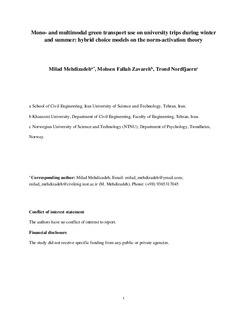| dc.contributor.author | Mehdizadeh, Milad | |
| dc.contributor.author | Zavareh, Mohsen | |
| dc.contributor.author | Nordfjærn, Trond | |
| dc.date.accessioned | 2019-11-15T07:22:08Z | |
| dc.date.available | 2019-11-15T07:22:08Z | |
| dc.date.created | 2019-09-23T11:41:34Z | |
| dc.date.issued | 2019 | |
| dc.identifier.issn | 0965-8564 | |
| dc.identifier.uri | http://hdl.handle.net/11250/2628637 | |
| dc.description.abstract | The current study investigated the effects of environmental norms and beliefs as well as socioeconomic and situational characteristics on multimodal and monomodal green transport and car use on university trips during winter and summertime in Norway. Our major contribution to the state of the art is threefold: (1) we tested the norm-activation model (NAM) as well as demographic, socioeconomic and situational characteristics in explaining modality use through developing a hybrid choice model (HCM), (2) we explored the predictors of modality use among university students, and (3) we empirically investigated how, and to what extent, seasonal variation (winter versus summer) impacts on the link between the NAM theory and modality use. A cross-sectional self-administered survey was carried out in February 2019 at two of the largest university campuses in Trondheim, Norway (Dragvoll and Gløshaugen). Out of 419 questionnaires distributed among students, 316 valid observations were used for analysis. Findings showed that: (1) the NAM theory was associated with multimodal and monomodal green mode use in summertime, while this relation was not supported for wintertime, (2) most of the students in the current sample were green transport-oriented, and (3) situational factors such as accessibility to public transit and cycling time to university were more important for modality use during wintertime than summertime. Policymakers could implement measures so as to provide availability of all green transport modes and routes, such as reliable and safe bicycle and walking paths, for all days during wintertime even during days with heavy snowfall in order to activate individuals’ moral obligations towards reducing car use and modal shifts from car to green transport modes. Furthermore, encouraging students to be multimodal green transport users could be a feasible policy in order to reduce the probability of any shift from a green-oriented mode to the car, even in days with exceptional weather during the winter season. | nb_NO |
| dc.language.iso | eng | nb_NO |
| dc.publisher | Elsevier | nb_NO |
| dc.rights | Attribution-NonCommercial-NoDerivatives 4.0 Internasjonal | * |
| dc.rights.uri | http://creativecommons.org/licenses/by-nc-nd/4.0/deed.no | * |
| dc.title | Mono- and multimodal green transport use on university trips during winter and summer: hybrid choice models on the norm-activation theory | nb_NO |
| dc.type | Journal article | nb_NO |
| dc.type | Peer reviewed | nb_NO |
| dc.description.version | acceptedVersion | nb_NO |
| dc.source.journal | Transportation Research Part A: Policy and Practice | nb_NO |
| dc.identifier.doi | 10.1016/j.tra.2019.09.046 | |
| dc.identifier.cristin | 1727736 | |
| dc.description.localcode | © 2019. This is the authors’ accepted and refereed manuscript to the article. Locked until 1.10.2021 due to copyright restrictions. This manuscript version is made available under the CC-BY-NC-ND 4.0 license http://creativecommons.org/licenses/by-nc-nd/4.0/ | nb_NO |
| cristin.unitcode | 194,67,40,0 | |
| cristin.unitname | Institutt for psykologi | |
| cristin.ispublished | true | |
| cristin.fulltext | postprint | |
| cristin.qualitycode | 2 | |

